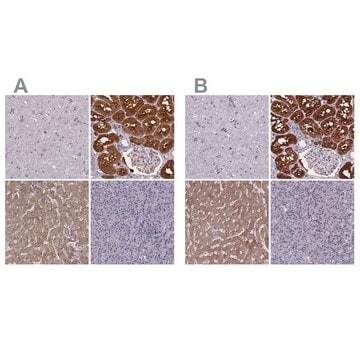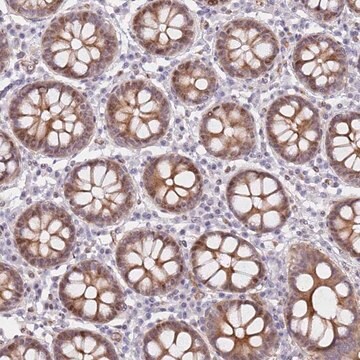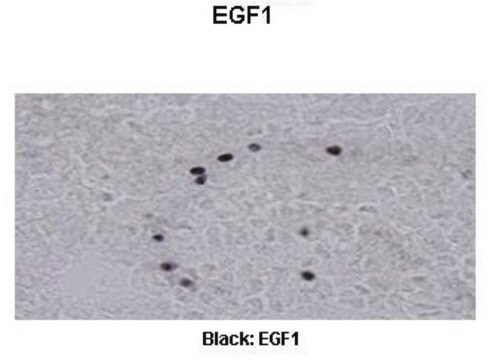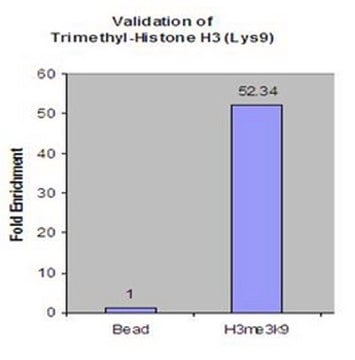일반 설명
We are committed to bringing you greener alternative products, which adhere to one or more of The 12 Principles of Green Chemistry. This antibody is Preservative-free, produced without the harm or sacrifice of animals and exceptionally stable to allow for ambient shipping and storage if needed and thus aligns with "Waste Prevention", "Designing Safer Chemicals" and "Design for Energy Efficiency".
Click here for more information.
ZooMAb® antibodies represent an entirely new generation of recombinant monoclonal antibodies. Each ZooMAb® antibody is manufactured using our proprietary recombinant expression system, purified to homogeneity, and precisely dispensed to produce robust and highly reproducible lot-to-lot consistency. Only top-performing clones are released for use by researchers. Each antibody is validated for high specificity and affinity across multiple applications, including its most commonly used application. ZooMAb® antibodies are reliably available and ready to ship when you need them.
특이성
Clone 1L14 is a ZooMAb® rabbit recombinant monoclonal antibody that specifically detects Phenylalanine-4-hydroxylase (PAH). It targets an epitope within 25 amino acids from the C-terminal region.
면역원
KLH-conjugated linear peptide corresponding to 25 amino acids from the C-terminal region of human Phenylalanine-4-hydroxylase (PAH).
애플리케이션
Quality Control Testing
Evaluated by Western Blotting in Rat liver tissue lysate,
Western Blotting Analysis: A 1:1,000 dilution of this antibody detected Phenylalanine 4-hydroxylase (PAH) in Rat liver tissue lysate.
Tested Applications
Western Blotting Analysis: A 1:1,000 dilution from a representative lot detected Phenylalanine-4-hydroxylase (PAH) in lysates from HepG2 cells and Human kidney and Mouse liver tissue.
Immunofluorescence Analysis: A 1:1,000 dilution from a representative lot detected Phenylalanine-4-hydroxylase (PAH) in Human kidney tissue sections.
Affinity Binding Assay: A representative lot of this antibody bound Phenylalanine-4-hydroxylase (PAH) peptide with a KD of 2.2 x 10-6 in an affinity binding assay.
Immunohistochemistry (Paraffin) Analysis: A 1:1,000 dilution from a representative lot detected Phenylalanine-4-hydroxylase (PAH) in human kidney tissue sections.
Note: Actual optimal working dilutions must be determined by end user as specimens, and experimental conditions may vary with the end user.
표적 설명
Phenylalanine-4-hydroxylase (UniProt: P00439; also known as EC:1.14.16.1, PAH, Phe-4-monooxygenase) is encoded by the PAH gene (Gene ID: 5053) in human. Phenylalanine-4-hydroxylase (PAH) is a rate-limiting, homodimeric enzyme that catalyzes the hydroxylation of L-phenylalanine to L-tyrosine by para-hydroxylation of the aromatic side-chain. It can also exist as a homotetramer. Its N-terminal region contains an allosteric binding site for phenylalanine and an inhibitory domain that regulates the activity of a catalytic domain in the C-terminal region. It uses tetrahydrobiopterin (BH4) and a non-heme iron for catalysis. In this reaction, BH4 functions as a co-substrate that is also hydroxylated at each turnover to pterin-4 carbinolamine (4a-OH-BH4), with consequent dissociation from the enzyme. The dehydration and reduction of 4a-OH-BH4 back to BH4 is catalyzed sequentially by pterin carbinolamine dehydratase. PAH deficiency results in the inability to convert the essential amino acid phenylalanine into tyrosine. It leads to hyperphenylalaninemia, the most common disorder in amino acid metabolism. PAH has an obligatory cofactor, tetrahydrobiopterin (BH4). Mutations in PAH gene have been linked to severe phenylketonuria, an autosomal recessive disorder that is characterized by high blood concentrations of phenylalanine, low tyrosine, and intellectual disability. This ZooMAb® recombinant monoclonal antibody, generated by our propriety technology, offers significantly enhanced specificity, affinity, reproducibility, and stability over conventional monoclonals. (Ref.: Flydal, MI., and Martinez, A. (2013). IUBMB Life. 65(4); 341-349; Bessman, SP. (1964). J. Pediatrics. 64(6); 828-838).
물리적 형태
Purified recombinant rabbit monoclonal antibody IgG, lyophilized in PBS with 5% Trehalose, normal appearance a coarse or translucent resin. The PBS/trehalose components in the ZooMAb formulation can have the appearance of a semi-solid (bead like gel) after lyophilization. This is a normal phenomenon. Please follow the recommended reconstitution procedure in the data sheet to dissolve the semi-solid, bead-like, gel-appearing material. The resulting antibody solution is completely stable and functional as proven by full functional testing. Contains no biocide or preservatives, such as azide, or any animal by-products. Larger pack sizes provided as multiples of 25 µL.
재구성
300 µg/mL after reconstitution at 25 µL per vial. Please refer to guidance on suggested starting dilutions and/or titers per application and sample type.
저장 및 안정성
Recommend storage of lyophilized product at 2-8°C; Before reconstitution, micro-centrifuge vials briefly to spin down material to bottom of the vial; Reconstitute each vial by adding 25 µL of filtered lab grade water or PBS; Reconstituted antibodies can be stored at 2-8°C, or -20°C for long term storage. Avoid repeated freeze-thaws.
법적 정보
ZooMAb is a registered trademark of Merck KGaA, Darmstadt, Germany
면책조항
Unless otherwise stated in our catalog or other company documentation accompanying the product(s), our products are intended for research use only and are not to be used for any other purpose, which includes but is not limited to, unauthorized commercial uses, in vitro diagnostic uses, ex vivo or in vivo therapeutic uses or any type of consumption or application to humans or animals.










